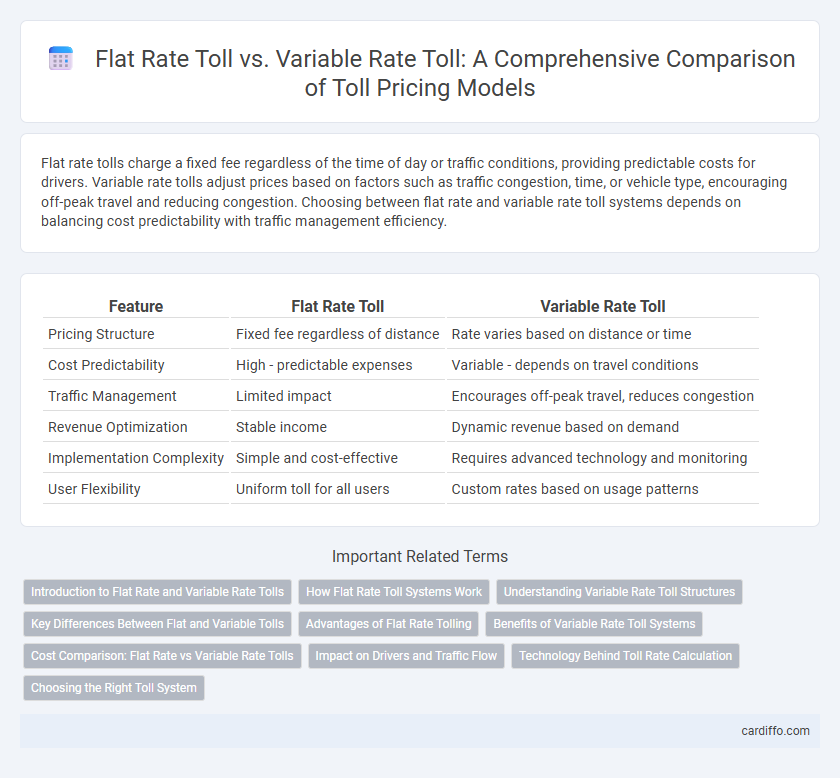Flat rate tolls charge a fixed fee regardless of the time of day or traffic conditions, providing predictable costs for drivers. Variable rate tolls adjust prices based on factors such as traffic congestion, time, or vehicle type, encouraging off-peak travel and reducing congestion. Choosing between flat rate and variable rate toll systems depends on balancing cost predictability with traffic management efficiency.
Table of Comparison
| Feature | Flat Rate Toll | Variable Rate Toll |
|---|---|---|
| Pricing Structure | Fixed fee regardless of distance | Rate varies based on distance or time |
| Cost Predictability | High - predictable expenses | Variable - depends on travel conditions |
| Traffic Management | Limited impact | Encourages off-peak travel, reduces congestion |
| Revenue Optimization | Stable income | Dynamic revenue based on demand |
| Implementation Complexity | Simple and cost-effective | Requires advanced technology and monitoring |
| User Flexibility | Uniform toll for all users | Custom rates based on usage patterns |
Introduction to Flat Rate and Variable Rate Tolls
Flat rate tolls charge a fixed fee regardless of the distance traveled, providing predictable costs for drivers on specific roads or bridges. Variable rate tolls adjust fees based on factors such as travel distance, time of day, or congestion levels, optimizing traffic flow and reducing congestion. Both toll systems aim to manage road usage while balancing revenue generation and commuter convenience.
How Flat Rate Toll Systems Work
Flat rate toll systems charge a fixed fee for using a road or bridge, regardless of distance traveled or time of day. This system simplifies toll collection by applying a consistent cost to all vehicles, making it efficient for users and operators. Flat rate tolls are commonly used in urban expressways and specific bridge crossings to streamline traffic flow and reduce bottlenecks at toll points.
Understanding Variable Rate Toll Structures
Variable rate toll structures adjust charges based on real-time traffic conditions, time of day, or vehicle type to manage congestion and optimize road usage. These dynamic tolls use sensors and algorithms to increase prices during peak hours, encouraging off-peak travel and reducing traffic buildup. Understanding the variability in toll pricing helps drivers anticipate costs and promotes more efficient transportation planning.
Key Differences Between Flat and Variable Tolls
Flat rate tolls charge a fixed fee regardless of distance traveled, offering predictable costs for drivers and simplifying toll collection processes. Variable rate tolls adjust fees based on factors such as distance, time of day, or traffic congestion, promoting efficient road usage and reducing congestion. The choice between flat and variable tolls impacts revenue management, traffic flow control, and user behavior in toll road operations.
Advantages of Flat Rate Tolling
Flat rate tolling offers predictable expenses for drivers, simplifying budgeting and reducing travel cost uncertainty. It eliminates delays at toll booths caused by rate calculations, improving traffic flow and minimizing congestion. Consistent pricing also enhances fairness and transparency, ensuring all users pay the same fee regardless of distance traveled.
Benefits of Variable Rate Toll Systems
Variable rate toll systems dynamically adjust fees based on traffic demand, reducing congestion and improving traffic flow on busy roadways. By encouraging off-peak travel, they optimize roadway capacity and decrease environmental impact through lower vehicle emissions. These systems also generate more equitable revenue by charging drivers according to real-time road usage intensity.
Cost Comparison: Flat Rate vs Variable Rate Tolls
Flat rate tolls charge a consistent fee regardless of distance or time, providing predictable costs for daily commuters. Variable rate tolls fluctuate based on factors such as traffic congestion, time of day, and vehicle type, often resulting in higher fees during peak hours but potential savings during off-peak periods. Choosing between flat and variable rates depends on travel patterns, with flat rates benefiting frequent, predictable routes and variable rates offering cost efficiency for occasional or flexible travel times.
Impact on Drivers and Traffic Flow
Flat rate tolls provide predictable costs for drivers, encouraging consistent use of toll roads but potentially causing congestion during peak hours due to uniform pricing. Variable rate tolls adjust prices based on traffic demand, effectively managing congestion by incentivizing off-peak travel and improving overall traffic flow. Drivers benefit from lower wait times and reduced traffic delays with variable tolls, while flat rate tolls offer simplicity and certainty in travel expenses.
Technology Behind Toll Rate Calculation
Flat rate toll systems utilize fixed pricing regardless of traffic conditions, relying primarily on static sensors and manual input for fee application. Variable rate toll systems employ advanced technologies such as RFID, GPS tracking, and real-time traffic monitoring to dynamically adjust toll prices based on congestion and time of day. Machine learning algorithms and cloud-based data analytics optimize rate calculation by predicting traffic patterns and enhancing revenue management.
Choosing the Right Toll System
Choosing the right toll system depends on traffic volume and revenue goals; flat rate tolls offer consistent fees regardless of congestion, ensuring predictable income, while variable rate tolls adjust charges based on traffic conditions to manage demand and reduce congestion. Urban areas with fluctuating traffic benefit from variable pricing that incentivizes off-peak travel, whereas flat rate tolls suit less congested routes with steady traffic patterns. Analyzing traffic data and user behavior is crucial to determining the most effective toll model for optimizing roadway efficiency and user satisfaction.
Flat Rate Toll vs Variable Rate Toll Infographic

 cardiffo.com
cardiffo.com